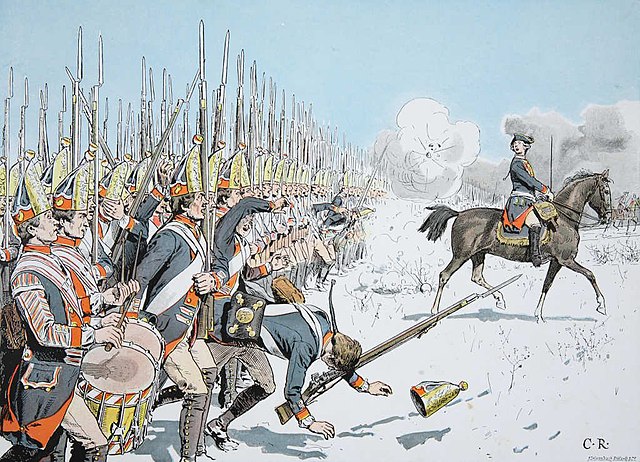The Battle of Leuthen was fought on 5 December 1757 between Frederick the Great's Prussian Army and an Austrian army commanded by Prince Charles of Lorraine and Count Leopold Joseph von Daun. Frederick used maneuver warfare and knowledge of the terrain to rout the larger Austrian force completely. The victory ensured Prussian control of Silesia during the Third Silesian War, which was part of the Seven Years' War.
Storming of the breach by Prussian grenadiers, Carl Röchling
Leuthen stands with rolling grasslands in which Charles distributed his troops in a long line across fields to the village visible in the distance. Charles directed his operations from the tower of one of the churches.
At Borne, Frederick the Great and his staff develop their battle plan, as illustrated by Hugo Ungewitter
Prussians advance at Leuthen, as imagined and illustrated by Carl Röchling (c. 1890)
Frederick II was the monarch of Prussia from 1740 until 1786. He was the last Hohenzollern monarch titled King in Prussia, declaring himself King of Prussia after annexing Royal Prussia from the Polish–Lithuanian Commonwealth in 1772. His most significant accomplishments include his military successes in the Silesian wars, his reorganisation of the Prussian Army, the First Partition of Poland, and his patronage of the arts and the Enlightenment. Prussia greatly increased its territories and became a major military power in Europe under his rule. He became known as Frederick the Great and was nicknamed "Old Fritz".
Portrait by Johann Georg Ziesenis (1763)
Portrait of 24-year-old Frederick as the crown prince of Prussia by Antoine Pesne (1736, Huis Doorn, Netherlands)
Frederick's marriage to Elisabeth Christine at Schloss Salzdahlum by J. G. Schmidt [de] (1733)
Rheinsberg Palace, Frederick's residence from 1736 to 1740







![Frederick's marriage to Elisabeth Christine at Schloss Salzdahlum by J. G. Schmidt [de] (1733)](https://upload.wikimedia.org/wikipedia/commons/thumb/3/3c/Arolsen_Klebeband_15_259.jpg/640px-Arolsen_Klebeband_15_259.jpg)
